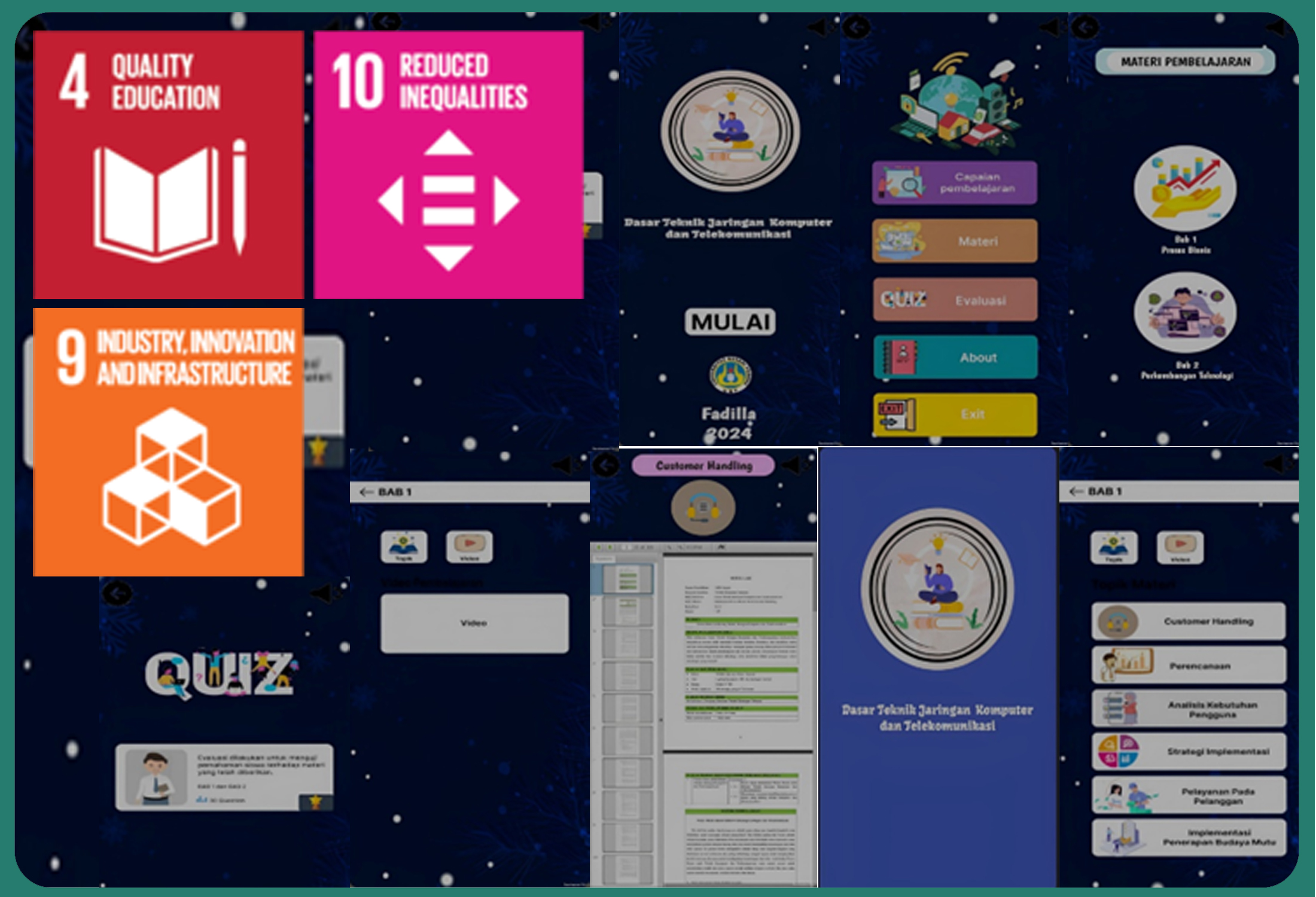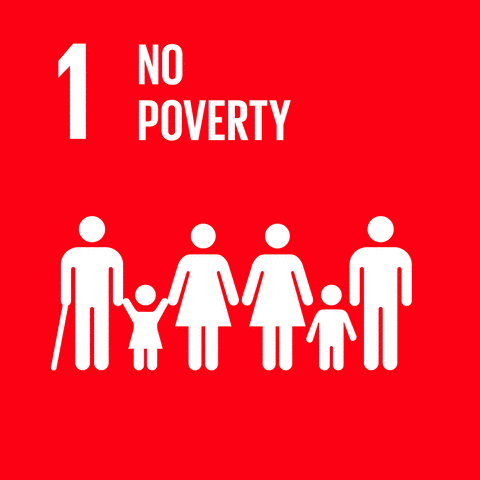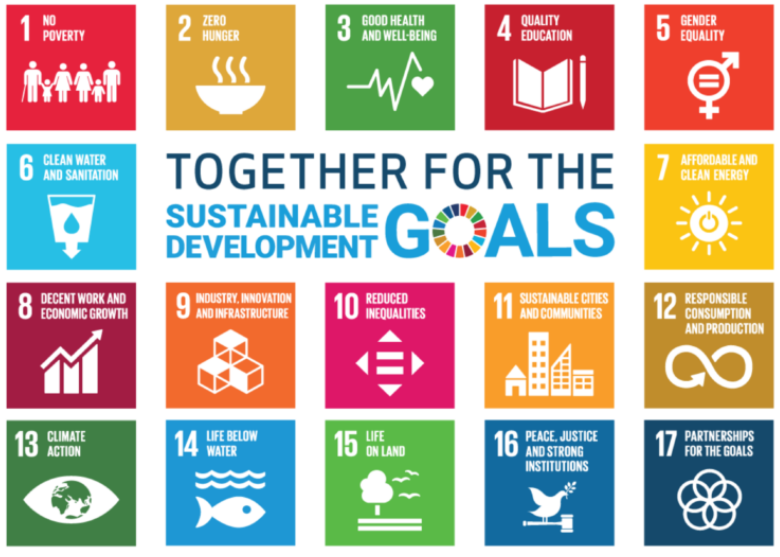Design and Development of Android-Based Interactive Learning Media for Basic Subjects in Computer and Telecommunication Network Engineering
DOI:
https://doi.org/10.24036/javit.v5i2.241Keywords:
Interactive Learning Media, Android Application, Vocational Education, Network Engineering, ADDIE Model, Mobile Learning, Educational TechnologyAbstract
The advancement of educational technology plays a pivotal role in improving student engagement and learning outcomes, especially in vocational education. This study aims to design and develop an Android-based interactive learning media application for the Basic Computer and Telecommunication Network Engineering course targeted at Grade X students of SMK Negeri 1 Sijunjung. The development process adopted the ADDIE model, encompassing five stages: Analysis, Design, Development, Implementation, and Evaluation. The application integrates multimedia elements such as text, images, instructional videos, and interactive quizzes, and was built using the Flutter framework to ensure compatibility across Android devices. Validation was conducted through expert reviews and user feedback. Material experts rated the application with an average feasibility score of 93.3%, while media experts provided a score of 91.3%. Additionally, student feedback revealed a high level of acceptance with an average satisfaction score of 88.52%. These results confirm the application's validity and effectiveness in enhancing student motivation and facilitating independent learning. This study highlights the potential of mobile-based interactive media as a complementary tool in vocational education and offers a foundation for future development integrating adaptive and collaborative learning features.
Downloads
References
Asmayawati, Yufiarti, and E. Yetti, “Pedagogical innovation and curricular adaptation in enhancing digital literacy: A local wisdom approach for sustainable development in Indonesia context,” J. Open Innov. Technol. Mark. Complex., vol. 10, no. 1, p. 100233, Mar. 2024, https://doi.org/10.1016/j.joitmc.2024.100233.
A. Krishnannair and S. Krishnannair, “Learning environments in higher education: Their adaptability to the 4th industrial revolution and the ‘social transformation’ discourse,” South African J. High. Educ., vol. 35, no. 3, pp. 65–82, Jul. 2021, https://doi.org/10.20853/35-3-4098.
N. M. Tri, P. D. Hoang, and N. T. Dung, “Impact of the industrial revolution 4.0 on higher education in Vietnam: challenges and opportunities,” Linguist. Cult. Rev., vol. 5, no. S3, pp. 1–15, 2021, https://doi.org/10.21744/lingcure.v5ns3.1350.
M. Manchanda and J. Arora, “Higher Education’s Position in Shaping the Workforce of the Future and the Importance of Adapting to the Digital Age,” Int. J. Educ. Reform, 2023, https://doi.org/10.1177/10567879231211285.
V. Basilotta-Gómez-Pablos, M. Matarranz, L. A. Casado-Aranda, and A. Otto, “Teachers’ digital competencies in higher education: a systematic literature review,” Int. J. Educ. Technol. High. Educ., vol. 19, no. 1, Dec. 2022, https://doi.org/10.1186/s41239-021-00312-8.
M. M. Bühler, T. Jelinek, and K. Nübel, “Training and Preparing Tomorrow’s Workforce for the Fourth Industrial Revolution,” Educ. Sci., vol. 12, no. 11, p. 782, Nov. 2022, https://doi.org/10.3390/educsci12110782.
L. Ghosh and R. Ravichandran, “Emerging Technologies in Vocational Education and Training,” J. Digit. Learn. Educ., vol. 4, no. 1, pp. 41–49, Apr. 2024, https://doi.org/10.52562/jdle.v4i1.975.
A. S. George and A. S. H. George, “Towards a Super Smart Society 5 . 0 : Opportunities and Challenges of Integrating Emerging Technologies for Social Innovation Partners Universal International Research Journal ( PUIRJ ) Towards a Super Smart Society 5 . 0 : Opportunities and Challenges of,” Partners Univers. Int. Res. J., vol. 3, no. June, pp. 0–29, Jun. 2024, https://doi.org/10.5281/ZENODO.11522048.
K. Frady, “Use of virtual labs to support demand-oriented engineering pedagogy in engineering technology and vocational education training programmes: a systematic review of the literature,” Eur. J. Eng. Educ., vol. 48, no. 5, pp. 822–841, Sep. 2023, https://doi.org/10.1080/03043797.2022.2141610.
N. Tarissa Ayu and N. Budiwati, “The Influence of Interactive Media Based on Information Technology on the Learning Effectiveness of Students,” J. Pendidik. Ekon. Indones., vol. 7, no. 1, pp. 74–90, May 2025, https://doi.org/10.17509/JPEI.V7I1.78136.
J. Jayaraman and J. Aane, “The Impact of Digital Textbooks on Student Engagement in Higher Education,” pp. 301–328, Jan. 2024, https://doi.org/10.4018/979-8-3693-3559-8.ch011.
J. I. Chisunum and C. N. Nwadiokwu, “Enhancing Student Engagement through Practical Production and Utilization of Instructional Materials in an Educational Technology Class: A Multifaceted Approach,” NIU J. Educ. Res., vol. 10, no. 2, pp. 81–89, Sep. 2024, https://doi.org/10.58709/NIUJED.V10I2.2002.
Dr. Lohans Kumar Kalyani, “The Role of Technology in Education: Enhancing Learning Outcomes and 21st Century Skills,” Int. J. Sci. Res. Mod. Sci. Technol., vol. 3, no. 4, pp. 05–10, Apr. 2024, https://doi.org/10.59828/ijsrmst.v3i4.199.
A. Alam and A. Mohanty, “Educational technology: Exploring the convergence of technology and pedagogy through mobility, interactivity, AI, and learning tools,” Cogent Eng., vol. 10, no. 2, Dec. 2023, https://doi.org/10.1080/23311916.2023.2283282.
M. Alenezi, S. Wardat, and M. Akour, “The Need of Integrating Digital Education in Higher Education: Challenges and Opportunities,” Sustain., vol. 15, no. 6, p. 4782, Mar. 2023, https://doi.org/10.3390/su15064782.
T. Väänänen, “Flutter in cross platform development : tools, performance and optimization,” laturi.oulu.fi, Feb. 2025, Accessed: Jul. 03, 2025. [Online]. Available: https://oulurepo.oulu.fi/handle/10024/54358.
C. Zhou, “Challenges and solutions in cross-platform mobile development: a qualitative study of Flutter and React Native.” May 20, 2024. Accessed: Jul. 03, 2025. [Online]. Available: https://aaltodoc.aalto.fi/handle/123456789/128177.
V. Bhardwaj, S. Zhang, Y. Q. Tan, and V. Pandey, “Redefining learning: student-centered strategies for academic and personal growth,” Front. Educ., vol. 10, p. 1518602, Feb. 2025, https://doi.org/10.3389/feduc.2025.1518602.
K. Hasibuan, A. Frista, and U. Sultan Syarif Kasim Riau, “Student-Centered Approaches to Curriculum and Course Design,” Innov. J. Soc. Sci. Res., vol. 5, no. 1, pp. 4472–4484, Jan. 2025, https://doi.org/10.31004/INNOVATIVE.V5I1.17162.
W. Pratama and B. Sudarsono, “Development Of Android-Based Occupational Safety and Health Learning Media to Improve Understanding of Work Accidents for Vocational High School Students,” VANOS J. Mech. Eng. Educ., vol. 9, no. 2, pp. 204–217, Nov. 2024, https://doi.org/10.30870/VANOS.V9I2.29354.
B. Susilo, D. Wijanarko, and Y. Sutopo, “Development of Android-Based Interactive Learning Media on the Application of Electronic Systems in Automotive Technology,” J. Vocat. Career Educ., vol. 8, no. 2, pp. 28–37, Dec. 2023, Accessed: Jul. 03, 2025. [Online]. Available: https://journal.unnes.ac.id/journals/jvce/article/view/6347.
S. Hartanto, A. Huda, R. E. Wulansari, A. Mubai, Firdaus, and Shalehoddin, “The Design of Android-Based Interactive Lean Manufacturing Application to Increase Students’ Work Skill in Vocational High School: The Development and Validity,” Int. J. Interact. Mob. Technol., vol. 16, no. 13, pp. 130–139, 2022, https://doi.org/10.3991/ijim.v16i13.30595.
C. L. Lee and R. Omar, “QR-driven mobile learning: enhancing TVET automotive education through interactive digital content,” Muall. J. Soc. Sci. Humanit., pp. 219–230, Jun. 2025, https://doi.org/10.33306/MJSSH/344.
N. Hardika, M. Suhairi, H. Maksum, S. Suhartini, and A. Permana, “Development of Learning Media Video Interactive Basic Motion Volleyball Game by Edpuzzle,” AL-ISHLAH J. Pendidik., vol. 16, no. 2, 2024, https://doi.org/10.35445/alishlah.v16i2.4782.
S. Supriusman, A. Daud, M. Mahdum, H. Hadriana, and A. Kurniawan, “Developing English Learning Media Using Edpuzzle for Understanding Language Expressions in a Listening and Speaking Class,” Tadris J. Kegur. dan Ilmu Tarb., vol. 8, no. 1, pp. 125–136, Jun. 2023, https://doi.org/10.24042/tadris.v8i1.14644.
X. Zhang, W. Qian, and C. Chen, “The effect of digital technology usage on higher vocational student satisfaction: the mediating role of learning experience and learning engagement,” Front. Educ., vol. 9, p. 1508119, Dec. 2024, https://doi.org/10.3389/feduc.2024.1508119.
B. Lu and R. N. Hanim, “Enhancing Learning Experiences through Interactive Visual Communication Design in Online Education,” Eurasian J. Educ. Res., vol. 2024, no. 109, pp. 134–157, 2024, https://doi.org/10.14689/ejer.2024.109.009.
J. Jayalath and V. Esichaikul, “Gamification to Enhance Motivation and Engagement in Blended eLearning for Technical and Vocational Education and Training,” Technol. Knowl. Learn., vol. 27, no. 1, pp. 91–118, Mar. 2022, https://doi.org/10.1007/s10758-020-09466-2.
A. A. Rafiq, M. B. Triyono, and I. W. Djatmiko, “Enhancing student engagement in vocational education by using virtual reality,” Waikato J. Educ., vol. 27, no. 3, pp. 175–188, Dec. 2022, https://doi.org/10.15663/wje.v27i3.964.
L. Malmi, J. Sheard, P. Kinnunen, Simon, and J. Sinclair, “Development and Use of Domain-specific Learning Theories, Models, and Instruments in Computing Education,” ACM Trans. Comput. Educ., vol. 23, no. 1, Dec. 2022, https://doi.org/10.1145/3530221.
C. W. Mayer, A. Rausch, and J. Seifried, “Analysing domain-specific problem-solving processes within authentic computer-based learning and training environments by using eye-tracking: a scoping review,” Empir. Res. Vocat. Educ. Train., vol. 15, no. 1, pp. 1–27, Dec. 2023, https://doi.org/10.1186/s40461-023-00140-2.
B. Çeken and N. Taşkın, “Multimedia learning principles in different learning environments: a systematic review,” Smart Learn. Environ., vol. 9, no. 1, pp. 1–22, Dec. 2022, https://doi.org/10.1186/s40561-022-00200-2.
N. N. Vu, B. P. Hung, N. T. T. Van, and N. T. H. Lien, “Theoretical and Instructional Aspects of Using Multimedia Resources in Language Education: A Cognitive View,” pp. 165–194, 2022, https://doi.org/10.1007/978-981-16-3828-2_9.
L. L. N. Pham, H. T. Nguyen, and V. T. K. Le, “Triggering Students’ Learning Autonomy Using the Combination of M-Learning and Gamification: a Case Study At Nguyen Tat Thanh University,” Teach. English with Technol., vol. 21, no. 2, pp. 66–91, 2021.
A. Alamer, A. Al Khateeb, and L. M. Jeno, “Using WhatsApp increases language students’ self-motivation and achievement, and decreases learning anxiety: A self-determination theory approach,” J. Comput. Assist. Learn., vol. 39, no. 2, pp. 417–431, Apr. 2023, https://doi.org/10.1111/jcal.12753.
A. Alamer and A. Al Khateeb, “Effects of using the WhatsApp application on language learners motivation: a controlled investigation using structural equation modelling,” Comput. Assist. Lang. Learn., 2021, https://doi.org/10.1080/09588221.2021.1903042.
Z. Yu, W. Xu, and P. Sukjairungwattana, “Motivation, Learning Strategies, and Outcomes in Mobile English Language Learning,” Asia-Pacific Educ. Res., vol. 32, no. 4, pp. 545–560, Aug. 2023, https://doi.org/10.1007/s40299-022-00675-0.
X. Lei, J. Fathi, S. Noorbakhsh, and M. Rahimi, “The Impact of Mobile-Assisted Language Learning on English as a Foreign Language Learners’ Vocabulary Learning Attitudes and Self-Regulatory Capacity,” Front. Psychol., vol. 13, p. 872922, Jun. 2022, https://doi.org/10.3389/fpsyg.2022.872922.
L. Araujo, F. Lopez-Ostenero, L. Plaza, and J. Martinez-Romo, “Automated Formative Feedback for Algorithm and Data Structure Self-Assessment,” Electron. 2025, Vol. 14, Page 1034, vol. 14, no. 5, p. 1034, Mar. 2025, https://doi.org/10.3390/ELECTRONICS14051034.
M. Hanses, L. van Rijn, H. Karolyi, and C. de Witt, “Guiding Students Towards Successful Assessments Using Learning Analytics From Behavioral Data to Formative Feedback,” pp. 61–83, 2024, https://doi.org/10.1007/978-3-031-56365-2_4.
A. Kulal, S. Dinesh, N. Abhishek, and A. Anchan, “Digital access and learning outcomes: a study of equity and inclusivity in distance education,” Int. J. Educ. Manag., vol. 38, no. 5, pp. 1391–1423, Jul. 2024, https://doi.org/10.1108/IJEM-03-2024-0166.

Downloads
Published
How to Cite
Issue
Section
License
Copyright (c) 2025 Fadilla Fadilla Fadilla, Efrizon, Mahesi Agni Zaus, Vera Irma Delianti

This work is licensed under a Creative Commons Attribution 4.0 International License.










